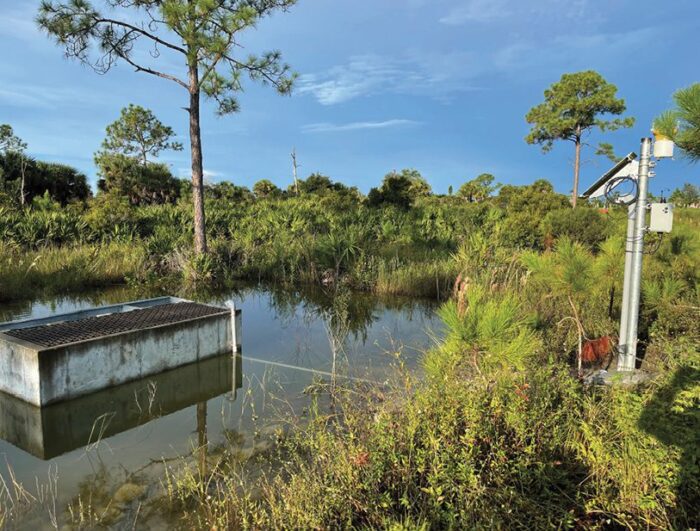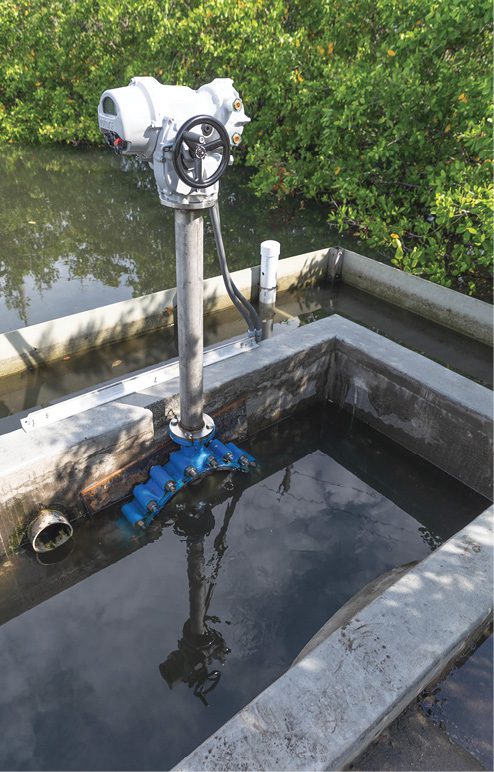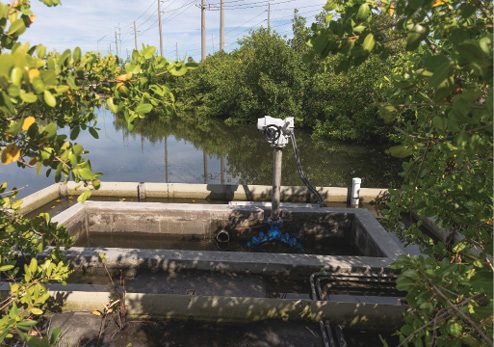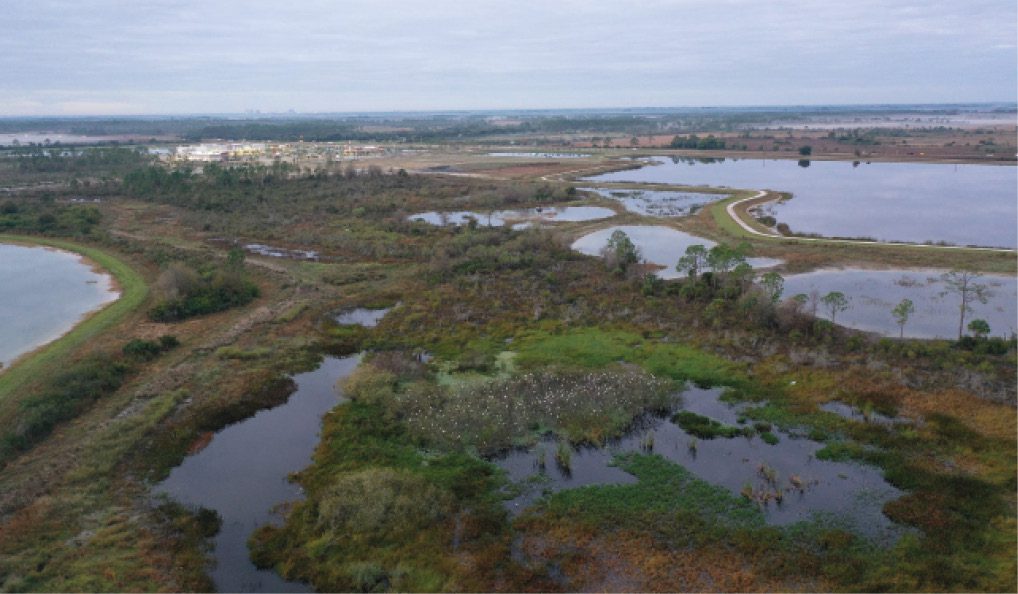Smart Ponds: Hurricane Ian Tests Stormwater Technology

A Smart Pond installation at Babcock Ranch in Florida.
Just a few months after Florida’s Port Tampa Bay installed National Stormwater Trust (NST) Smart Pond technology, Hurricane Ian made landfall in the area, causing extensive flood and wind damage—but not at Port Tampa Bay.
NST is a stormwater-focused company that assumes responsibility for the operation of existing stormwater ponds and deploys technology to provide state-of-the-art stormwater management and treatment services to improve performance, reduce flooding risk, and benefit the environment, notes Jeff M. Littlejohn, P.E., NST president. Company spokesperson Lisa Wolf-Chason credits the Smart Pond for helping the Port Tampa Bay area evade flooding from Hurricane Ian.
A conventional stormwater pond is designed and built to hold runoff. “Unfortunately, in large storms, conventional ponds can overflow and flood the surrounding area with untreated stormwater,” notes Littlejohn.
Smart Pond is designed to connect a pond to live weather forecast data, using that information to project water levels and, if necessary, automatically lower its water level before a storm arrives. NST Smart Ponds are solar powered with seven days of battery backup; constructed to withstand hurricane-force winds; and have an onboard, ruggedized industrial computer to operate autonomously in the event of a widespread loss of power or network data coverage. They’re also designed to be resilient enough to handle back-to-back hurricanes.
“The treated water in the [Port Tampa Bay] pond was able to be drained pre-storm, creating a large volume to receive stormwater during the storm,” says Wolf-Chason. “In a traditional stormwater pond, it would have remained full of treated water, and additional stormwater would have overflowed untreated into the bay and potentially flooding surrounding areas.”
Port Side
Smart Pond technology was installed in summer 2022 at Port Tampa Bay, Florida’s largest port by tonnage and real estate. Hurricane Ian made landfall on Florida’s southwest Gulf Coast in late September of that year. The weather event resulted in estimated losses of more than $50 billion, much brought on by flooding from a storm surge of 10 to 15 feet as well as a loss of at least 157 lives.
In Tampa Bay and the Port Tampa Bay area, the water level in the Smart Pond was automatically lowered by almost 4 feet before the first hurricane bands began to impact the region. The extra storage enabled the Smart Pond to capture more than 175,000 cubic feet of untreated stormwater, preventing its discharge into the neighboring community and nearby Tampa Bay.


An actuated valve at a Smart Pond next to Port Tampa Bay is open to release water in advance of an approaching storm.
“We couldn’t be more pleased with the performance of our six NST Smart Ponds in the path of Hurricane Ian,” notes Littlejohn. “Our primary focus is on improving water quality. But when a storm of that size is headed toward Florida, our objective shifts to protecting our communities and the environment from the flooding impacts of stormwater.”
In general, “water-quality benefits are also achieved, since pre-storm discharges from a Smart Pond are cleaner than post-storm discharges from a conventional pond,” he adds.
Port Tampa Bay has been in the channel-side area for more than 100 years and is surrounded by a vibrant commercial district. Installing Smart Pond technology was deemed an effective alternative to conventional stormwater ponds and vaults, which can be land- and cost-prohibitive inside the Port.
“Stormwater vaults are very expensive and become a maintenance problem over time due to the load traffic from cranes and forklifts,” adds Wolf-Chason. “Stormwater ponds are very land-area demanding and often conflict with the Port’s growth needs. This Smart Pond option is located just outside of the Port, is owned by the Florida Department of Transportation (FDOT) and is professionally operated in partnership with National Stormwater Trust.”
NST recently partnered with FDOT to retrofit its conventional ponds into Smart Ponds to improve their operational performance and provide regional water quality and flood-control benefits.

A photo shows a Florida Department of Transportation Smart Pond installation along State Road 45.
“Through this public-private partnership with FDOT, NST develops, permits and operates FDOT stormwater facilities and can permanently reserve a specified volume of offsite stormwater treatment capacity to meet the stormwater treatment requirements of its customers,” says Littlejohn.
With this arrangement in place, NST’s end users can fully develop their property without setting aside the land or capital typically required for stormwater infrastructure.
“Further, long-term costs associated with stormwater facility operation and maintenance are avoided and, under certain circumstances, existing stormwater facilities may be eligible for decommissioning and development after being re-permitted in an offsite NST facility,” adds Littlejohn. “The FDOT’s benefits from the partnership include revenue sharing and the transfer of regulatory and operational responsibilities to NST.”
With the Smart Pond technology, Port Tampa Bay can treat more water than needed to provide a net benefit to the environment, while keeping valuable land available for other development with low maintenance costs. NST is working with businesses, local governments and residential communities throughout Florida to deploy the forecast-based control of stormwater infrastructure from OptiRTC, a provider of smart stormwater management, and continuous monitoring and adaptive control technology.

The interconnected lakes and wetlands at Babcock Ranch provide ample storage for stormwater to keep structures high and dry.
Back at the Ranch
Smart Pond technology also proved its value during Hurricane Ian at Babcock Ranch, a 17,000-acre planned community in southeastern Charlotte County and northeastern Lee County, Fla., located near the Caloosahatchee River. NST Smart Ponds installed there in summer 2021 used live rainfall forecasts to project the impact of Hurricane Ian before its arrival.
This real-time flood-forecasting capability gave the community’s leaders assurance that its large lakes had adequate storage to contain the stormwater and protect the homes, roadways and schools.
“Because of the amount of rainfall and probability of extreme storm events, it was important to be able to accurately understand our stormwater system to adequately prepare for extreme events and protect the infrastructure within the community,” says Amy Wicks, lead engineer for surface-water management at Babcock Ranch.
Wicks notes that most of the rainfall in the region occurs in only a three-month timespan, and many of the rain events are quite intense—it’s not atypical to get a 5-inch rainfall in a single hour. In addition, the topography is extremely flat, so runoff is much slower than in most places.
“National Stormwater Trust approached Babcock Ranch and helped us understand how the system could be a benefit to Babcock,” says Wicks. “After several site visits with the team and answering many questions, we felt like the NST system was a great fit for our needs. Presently, we are only utilizing the system-monitoring components and utilize traditional fixed weirs.”
The technology allowed Wicks and her team to observe how the surface-water management system was functioning throughout the entire hurricane, providing the ability to alert residents if lake levels were to become critically high, which fortunately they did not.
The onsite ponds presently don’t have active controls in place and only utilize standard weirs designed to attenuate flow to pre-development levels. The weirs, when flowing, flow into the communities’ preserved natural paths and ultimately offsite. The area evaded flooding because of the resilient planning and design of the current water-management system.
“The current system is based on redundancy throughout the entire community by ensuring that all the stormwater features are connected in more than one location, and no parts of the system are isolated,” adds Wicks. “Additional storage is also provided throughout the community in rain gardens, wetlands and natural floodways that allow potential floodwaters to instead stack and store in areas away from critical infrastructure.”

Native species are flocking to restored wading bird habitat at Babcock Ranch.
A Variety of ROI
There are several business use cases for deploying stormwater-management technology, notes Littlejohn. “Depending on the end user, benefits can be derived from the increased developable area. Smart Ponds are about 50 percent more efficient, so the size of a pond can be reduced, which leaves more land area for other uses.”
Other business use cases include improvement in water quality from a retrofit of an existing pond as well as reduction in flood risk as pre-storm drawdowns create extra capacity to store stormwater and reduce flooding.
Wicks says Babcock Ranch expects to derive an ROI in its investment in Smart Pond technology through the ability to provide a storm-safe place for residents.
Another benefit is the positive impact on the human workforce. Wolf-Chason points out that the solar-powered system requires almost no manual labor to perform daily functions. And although it requires periodic manual maintenance every few years, all maintenance is performed by NST.
“There are certainly workforce benefits associated with remote monitoring of stormwater ponds,” adds Littlejohn. “For example, a Smart Pond can alert a maintenance team about a blocked, clogged or obstructed outfall before it becomes a flooding problem or major damage occurs.”
Wicks notes that when activated, the technology will allow for system changes to happen remotely, even during a storm, ensuring workforce safety. She advises stormwater managers considering new technology options that “the ability to provide peace of mind to residents as extreme events become more common is an immeasurable value that cannot be overlooked.”
“Consider this a new solution to stormwater management,” notes Wolf-Chason. “When land is readily available, a conventional stormwater pond may be the right solution. But as the demand for land becomes greater and stormwater regulations tighten to improve water quality, a Smart Pond can create valuable additional water-quality treatment without the need for extra land or expensive underground vaults.”
About Carol Brzozowski
Carol Brzozowski is a freelance journalist specializing in technology, resource management and construction topics; email: [email protected].


